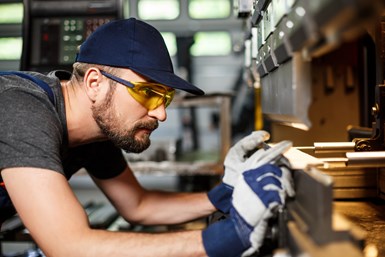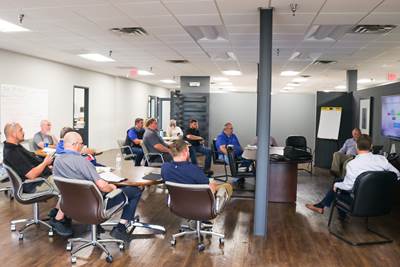
Small to mid-size mold builders often rely on handshakes and purchase orders, but as a shop nears a sale, leadership must change its business practices.
Although often shrouded in overly complicated financial terms, business valuations are generally straightforward. As a baseline, companies are worth the amount of cash they generate each year, times some “multiple” heavily influenced by the attractiveness of the relevant industry. Within each industry, larger companies will trade at higher multiples than will smaller ones.
In today's market, a typical multiple for a smaller plastic injection mold builder is five. That means the business would be worth five times its annual cash flow. Still, that multiple may increase if the business is growing, has newer equipment, serves attractive end markets, has higher-than-average margins, or has strategic importance to a particular OEM or molding company.
Similarly, mold builders with older equipment, poor margins and year-over-year revenue declines might be valued at less than five times cash flow. Larger mold builders can sometimes bring double-digit multiples.
So, a mold builder has the opportunity to improve the value of its business if it can increase its cash flow or make itself more attractive to potential buyers, thereby increasing the applicable multiple, and several strategies can drive both outcomes.
Here are a few management strategies to help mold builders improve their valuation:
1. Service key end markets. Moldmakers, who predominantly service growing and recession-resistant end markets such as healthcare and packaging, will command a higher multiple than those who do not. Automotive, light industrial and consumer durables all offer fine work, but the cyclical nature of those end markets makes investing in the moldmakers who serve them less attractive to investors.
Therefore, if your shop is relatively full and you're choosing among several pieces of business, chase healthcare and packaging work aggressively (and price that business aggressively).
2. Automate. If you can add automation to a CNC or EDM and save labor costs—fewer operators or less overtime—do it! Any automation that pays for itself in a year is always worth the investment. Generally, automation can take five years to pay for itself, but that is still worth the investment.

Money saved with automation can greatly impact sale proceeds.
Every dollar saved using a robot is five or more dollars in sale proceeds you will receive when you sell the business. Many moldmakers do not realize that equipment providers will offer deferred payment terms (sometimes as much as a year after receipt) and that equipment finance companies offer extremely competitive financing (often with lower interest rates than your local bank).
3. Upgrade equipment. When considering an equipment purchase, pay particular attention to the opportunity to reduce labor costs and improve productivity with higher-axis and higher-speed equipment. More advanced CNC mills will allow a shop to hard mill to finish dimensions more often, rather than burning. Plus, milling is usually three times faster. More axes mean fewer setups and more applications that can run lights out, etc.

Buy equipment that will reduce labor costs and improve productivity.
These cost savings mean better cash flow, and the reduced machine hours mean more sales—both in capacity and because the molds are more cost-competitive. Of course, more efficient equipment means fewer machine hours and lower prices, but you run the risk of falling behind the market and losing work. Every leading mold builder is heavily invested in the newest and best equipment along with associated automation, and those moldmakers are working on very long lead times due to the demand for their work.
4. Grow, even if you need to reduce prices modestly. Every business—moldmakers included—has fixed costs (rent, management, utilities, etc.) regardless of the amount of business in the shop. Fixed costs are covered in the budget, which (subject to competitive pressure) drives machine rates. If you can grow beyond your budget, the extra work is more profitable than the work you've budgeted, because the work you budgeted has already covered your fixed costs. Taking an additional job at slightly less margin may seem unattractive, but in reality, that work improves your cash flow more than the baseline work in your budget, and you will be paid some multiple of that cash flow at the time of sale.
Potential buyers for your business will include private equity funds and molding companies who believe that adding mold and toolmaking is important strategically. Molders are incredibly excited by mold builders who have relationships directly with the OEMs whose parts are made in these molds.
5. Manage your working capital. Buyers will expect you to leave "normalized" working capital (inventory and receivables) with the business at the sale. The idea is that the buyer doesn't want to inject cash into the business to pay its bills the day after closing (which a buyer would view as an additional purchase price). Normalized working capital is some average over the preceding 12 to 36 months. To maximize the sale proceeds, reduce inventory and speed receivables collection in the 12-36 months before you sell, driving down your averages.
For example, don't buy mold bases or electrodes to have safety stock, discuss with your supplier or distributor whether you can buy on consignment, or pursue vendor managed inventory (VMI) programs with your cutting tool supplier. The tighter you manage inventory, the less inventory the buyer will expect to receive in the sale, and the more cash you'll have in your pocket.
6. Manage your risks. Smaller mold builders often work on handshakes and purchase orders, but business practices must evolve as a shop approaches a sale. If you don't have terms and conditions on your website or in every quote that covers your warranty obligations, you should. Buyers will have concerns about the risk of potentially unlimited liability, and a large warranty claim in the 12-36 months leading up to a sale could crush your profits and reduce your sale proceeds by multiples of every dollar for every dollar you spend fixing a mold or covering damages incurred by your customer or its molding partner.
Develop and employ terms and conditions and specific preventative maintenance (PM) requirements (as a condition to your warranty) to ensure that you're not stuck refurbishing a mold that you should not be obligated to repair. Insist that your mold base and component suppliers provide warranties that match those you provide your customers. Also, don't be afraid to approach your customers about a long-term PM program because that revenue (and the spares you'll manufacture) will improve your profitability and the value you can command in a sale.

A mold builder who enables a buyer to become an approved supplier to large company will significantly increase the shop’s value.
7. Value your customers. Potential buyers for your business will include private equity funds and molding companies who believe that adding mold and toolmaking is important strategically. Molders are incredibly excited by mold builders who have relationships directly with the OEMs whose parts are made in these molds.
Your direct customer may be the molder running your mold, but use whatever influence you have to develop a relationship with (and become an approved supplier to) the OEMs who ultimately buy your molds. For example, your ability to enable your buyer to become an approved supplier to the largest consumer packaged goods and healthcare companies will significantly increase your business's value.
About the Author
Jim Berklas is a former full-time M&A lawyer for several of the largest private equity firms in the country. He has twenty-five years of M&A experience and 200 closed transactions—most recently, he co-founded medical device manufacturer Westfall Technik, Inc.
Related Content
Making Mentoring Work | MMT Chat Part 2
Three of the TK Mold and Engineering team in Romeo, Michigan join me for Part 2 of this MMT Chat on mentorship by sharing how the AMBA’s Meet a Mentor Program works, lessons learned (and applied) and the way your shop can join this effort.
Read MoreOEE Monitoring System Addresses Root Cause of Machine Downtime
Unique sensor and patent-pending algorithm of the Amper machine analytics system measures current draw to quickly and inexpensively inform manufacturers which machines are down and why.
Read MoreHow to Improve Your Current Efficiency Rate
An alternative approach to taking on more EDM-intensive work when technology and personnel investment is not an option.
Read MoreThe Role of Social Media in Manufacturing
Charles Daniels CFO of Wepco Plastics shares insights on the role of social media in manufacturing, how to improve the “business” side of a small mold shop and continually developing culture.
Read MoreRead Next
Taking Care of the People Side of an Acquisition
Focusing on the human side of the business—employee health, safety, success and growth—is the only way to satisfy both the buyer and seller.
Read MoreMMT Chats: Tips for a Successful Acquisition
MoldMaking Technology Editorial Director Christina Fuges chats with Fran Brunelle, President of Accelerated Manufacturing Brokers about the ins and outs of today's successful manufacturing mergers and acquisitions.
Read MoreHow to Use Continuing Education to Remain Competitive in Moldmaking
Continued training helps moldmakers make tooling decisions and properly use the latest cutting tool to efficiently machine high-quality molds.
Read More






















.jpg;maxWidth=970;quality=90)